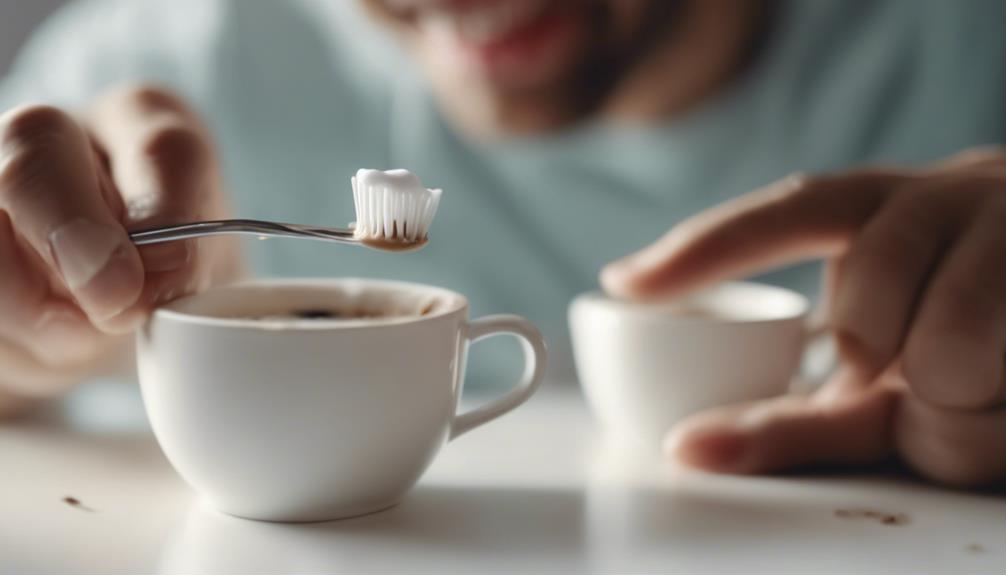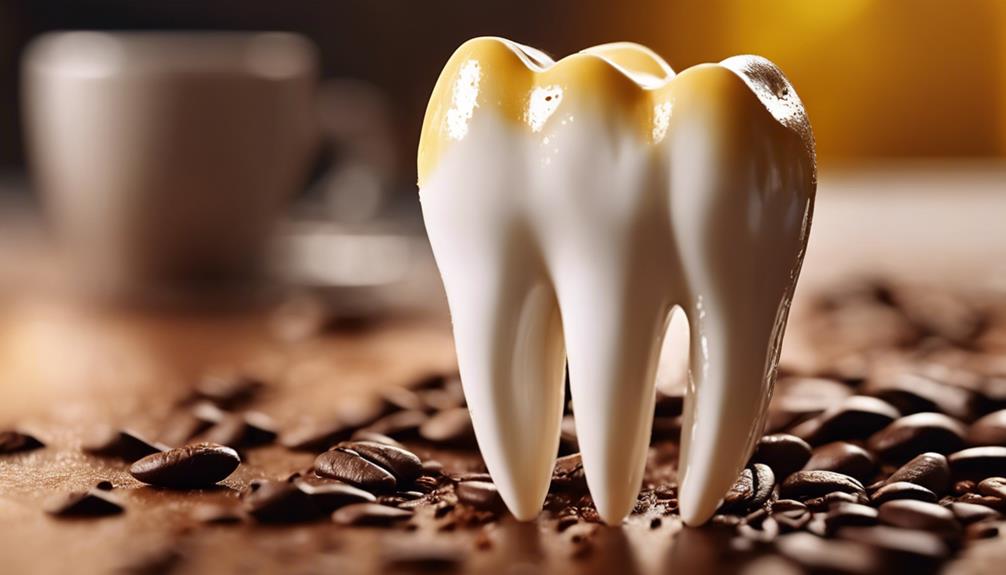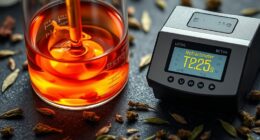To maintain white teeth while still enjoying your coffee, try reducing your coffee intake and switching to green tea. You can also decrease the chances of staining by avoiding creamer and sugar, drinking your coffee quickly, using a straw for iced coffee, and waiting to brush your teeth. Choose teeth-cleaning foods and whitening products such as professional treatments, at-home kits, or natural remedies. By incorporating these adjustments along with proper dental hygiene, you can keep your smile bright even while consuming coffee. More information on these techniques can help you in preserving white teeth.
Key Takeaways
- Gradually reduce coffee intake to minimize staining compounds exposure.
- Switch to green tea with fewer tannins for whiter teeth.
- Avoid creamer and sugar to prevent discoloration and enamel erosion.
- Drink coffee in one sitting to lessen teeth staining chances.
- Use a straw with iced coffee to protect enamel from staining compounds.
Reducing Coffee Consumption
To maintain white teeth, consider cutting back on your coffee consumption gradually. Limiting your intake of coffee can greatly reduce the exposure of your teeth to staining compounds, thereby helping to prevent long-term discoloration. By decreasing the frequency of your coffee consumption, you can also minimize the impact on your tooth enamel, providing better protection for your teeth. Consuming coffee in moderation is key to decreasing the likelihood of teeth stains and contributing to maintaining whiter teeth over time.
Reducing your coffee consumption is a proactive step towards white teeth maintenance. It's an essential part of teeth whitening strategies as it helps to minimize discoloration and protect your enamel. By gradually reducing your coffee intake, you can work towards a brighter smile while still enjoying your favorite beverage in moderation.
Switching to Green Tea

Considering the benefits of green tea for maintaining white teeth, switching from coffee to green tea is a wise choice. Green tea contains fewer tannins than coffee, which helps reduce the risk of teeth staining.
The antioxidants present in green tea can aid in fighting bacteria and preventing plaque buildup on your teeth. Additionally, drinking green tea can lower the acidity levels in your mouth, decreasing the chances of enamel erosion compared to coffee.
Making the switch to green tea can be a healthier alternative for coffee drinkers looking to maintain white teeth. By incorporating green tea into your daily routine, you can contribute to better oral health and gradually achieve whiter teeth over time.
Avoiding Creamer and Sugar

Avoiding creamer and sugar in your coffee can have a major impact on the whiteness of your teeth. Creamer can contribute to tooth discoloration, while sugar promotes staining and bacteria growth.
Choosing alternatives like black coffee or almond milk can help maintain a brighter smile and improve your overall oral health.
Creamer Effects on Teeth
Creamer and sugar in your coffee can greatly affect the health and appearance of your teeth. The creamer you add to your coffee can contribute to staining teeth and weakening tooth enamel. The sugar in your coffee can also create an acidic environment in your mouth, promoting plaque formation and potentially leading to enamel erosion.
These effects can be detrimental to your oral hygiene habits and overall dental health.
To mitigate these negative impacts, consider opting for alternatives like black coffee or almond milk instead of creamer and sugar. This choice can help reduce the risk of dental issues associated with creamer and sugar, such as discoloration and bacterial growth.
Sugar's Staining Impact
Using black coffee or natural sweeteners instead of creamer and sugar can greatly reduce the risk of tooth discoloration and maintain whiter teeth. Sugar is a major culprit when it comes to staining teeth. It feeds harmful bacteria in the mouth, leading to plaque buildup and enamel erosion, which can result in yellowing of teeth. By cutting out sugar from your coffee, you not only improve your oral hygiene routine but also prevent staining.
Opting for black coffee or natural sweeteners can help you avoid these issues and keep your smile bright. Remember, maintaining white teeth goes beyond just brushing; it also involves making smart choices like avoiding sugar that can harm your teeth. So next time you reach for your coffee, consider skipping the creamer and sugar for the sake of your pearly whites. Your teeth will thank you for it in the long run.
Alternatives for Whitening
How can you enhance the whiteness of your teeth while enjoying your morning cup of coffee? Avoiding creamer and sugar is a great start to prevent discoloration and bacteria growth on your teeth. Instead, consider alternatives for whitening your teeth to counteract the potential staining effects of these additives. Here are some options to help you maintain a bright smile:
| Whitening Method | Description |
|---|---|
| Whitening toothpaste | Contains mild abrasives or polishing agents to remove surface stains. |
| Whitening treatments | Professional treatments like bleaching gels applied by a dentist to whiten teeth. |
| Whitening strips | Thin, flexible strips coated with a whitening gel that adhere to your teeth. |
Drinking Coffee in One Sitting

Drinking your coffee in one sitting can actually help reduce the chances of staining your teeth. By taking short sips, you limit the exposure time to the compounds that cause discoloration.
Remember to rinse your mouth after finishing your coffee and consider using a straw sparingly to minimize contact with your teeth.
Short Sips Reduce Stains
To reduce stains from coffee on your teeth, consider drinking your coffee in one sitting to minimize prolonged exposure. Taking short sips can help reduce the duration of contact between the coffee and your teeth, limiting the chances of discoloration.
Here are some tips to keep in mind:
- Sip Quickly: Consuming your coffee swiftly decreases the exposure time of tannins that can bind to your enamel and cause stains.
- Limit Sipping: Taking short sips instead of continuous sipping can help prevent prolonged contact between the coffee and your teeth, reducing the risk of discoloration.
- Be Mindful of Time: Try to finish your coffee within a reasonable timeframe to minimize the effects of tannins and color compounds on your teeth.
Rinse After Drinking
After finishing your coffee in one sitting, remember to rinse your mouth with water to remove tannins and prevent staining on your teeth. This essential step can help eliminate the residue left by coffee, reducing the chances of coffee stains on your teeth.
When you drink coffee continuously, the exposure time of your teeth to coffee increases, leading to a higher risk of staining. Rinsing your mouth with water after consuming coffee not only helps in removing tannins but also eliminates bacteria and sugar that could harm your teeth.
It's vital to maintain good oral hygiene practices, and rinsing after coffee consumption can contribute to keeping your teeth white and healthy. By limiting direct contact of coffee with your teeth and incorporating rinsing into your routine, you can safeguard your teeth from the potential discoloration caused by coffee.
Use Straw Sparingly
Consider using a straw sparingly when enjoying your coffee in one sitting to minimize direct contact with your teeth and reduce the risk of staining.
Drinking coffee through a straw is a simple way to protect your teeth from the compounds in coffee that can stain your teeth. When you use a straw, the coffee bypasses your front teeth, decreasing the chances of discoloration.
Here are some tips to help you protect your teeth while still enjoying your coffee:
- Opt for a reusable straw to reduce waste and lessen your environmental impact.
- Avoid using plastic straws that can harm marine life and contribute to pollution.
- Consider metal or silicone straws as durable and eco-friendly alternatives for sipping your coffee.
Using a Straw for Iced Coffee

Using a straw while enjoying your iced coffee can help protect your teeth from potential staining and discoloration. Straws act as a barrier, minimizing direct contact between the dark compounds in coffee and your enamel, ultimately reducing the risk of discoloration.
By opting for a straw when sipping on your iced coffee, you're taking a proactive step towards maintaining the natural whiteness of your teeth. It's recommended to choose reusable metal or bamboo straws not only for their eco-friendly nature but also for their effectiveness in preventing staining.
Next time you reach for that invigorating iced coffee, consider using a straw to safeguard your pearly whites. This simple adjustment in your coffee-drinking routine can go a long way in preserving the brightness of your teeth.
Brushing Teeth After Consumption

To maintain the whiteness of your teeth after enjoying your iced coffee, it's essential to think about the timing of brushing your teeth.
Here are some key points to take into account:
- Wait at least 30 minutes: Brushing your teeth immediately after consuming coffee can lead to enamel damage due to the acidic nature of coffee. Waiting for a minimum of 30 minutes can help protect your enamel from erosion.
- Use whitening toothpaste: Brushing with whitening toothpaste can effectively remove surface stains caused by coffee consumption. Incorporating this into your daily oral hygiene routine can help maintain the whiteness of your teeth.
- Consider professional whitening services: For more intensive stain removal, professional teeth whitening services can be a valuable option. These services can provide a deeper clean to combat the effects of coffee on stained teeth.
Incorporating Teeth-Cleaning Foods

Incorporate teeth-cleaning foods like strawberries and lemons into your diet to benefit from their natural properties that can help whiten your teeth. Strawberries contain malic acid, which aids in removing surface stains, while lemons with citric acid can brighten teeth when used cautiously. These foods, when incorporated wisely, can complement your oral hygiene routine. However, be mindful of acidic foods to prevent enamel erosion and consult with a dentist for guidance. Here is a table highlighting some teeth-cleaning foods that you can easily add to your diet:
| Teeth-Cleaning Foods | Benefits |
|---|---|
| Strawberries | Malic acid for stain removal |
| Lemons | Citric acid for brightening |
| Carrots | Crunchy texture helps clean teeth |
| Apples | High water content stimulates saliva production |
| Celery | Natural fibers scrub teeth |
Utilizing Whitening Products

Whitening products, such as whitening toothpaste and professional services, can effectively combat stains caused by coffee consumption. When it comes to achieving a brighter smile, here are some essential methods to take into account:
- Professional services: Dentists offer specialized treatments that can provide visibly whiter teeth through personalized plans tailored to your needs.
- At-home kits: Dentist-recommended whitening kits or strips can be a convenient and effective way to tackle coffee stains from the comfort of your home.
- DIY methods: Utilizing household items like baking soda, hydrogen peroxide, or coconut oil pulling can also aid in teeth whitening when used correctly.
Frequently Asked Questions
How Do Coffee Drinkers Keep Their Teeth White?
To keep your teeth white as a coffee drinker, you can take simple steps like rinsing with water after coffee, using a straw to minimize contact, and brushing with whitening toothpaste.
Regular oral hygiene routines of brushing and flossing are essential. For stubborn stains, consider professional whitening.
These practices can help maintain a bright smile despite enjoying your daily cup of coffee.
How Do People Drink Coffee Without Staining Teeth?
To drink coffee without staining teeth, consider these tips:
- Use a straw to minimize direct contact with teeth.
- Mix in milk or cream to neutralize enamel-damaging compounds.
- Rinse your mouth with water after coffee to remove tannins and prevent stains.
- Chew sugar-free gum to reduce acid buildup and protect teeth.
- Opt for cold brew coffee, which has lower acidity and is a teeth-friendly alternative to hot coffee.
These simple strategies can help you maintain white teeth while still enjoying your coffee.
Why Do I Love Coffee but My Teeth Are Yellow?
If you love coffee but notice your teeth turning yellow, it's likely due to the tannins and acidity in coffee. Tannins stick to teeth, causing yellowing, while acidity can erode enamel, making teeth more prone to discoloration.
Factors like genetics and oral care also play a role. To combat yellowing, consider using whitening products and maintaining good oral hygiene. These strategies can help offset the effects of regular coffee consumption on your teeth.
How Do You Reverse Yellow Teeth From Coffee?
To reverse yellow teeth from coffee stains, start by considering professional teeth whitening treatments, like those that effectively combat discoloration caused by coffee.
Utilizing whitening toothpaste or strips containing hydrogen peroxide can also assist in reducing yellowing from coffee consumption.
Regular dental cleanings and check-ups play an essential role in preventing and reversing coffee-induced stains.
Implementing these practices, in addition to home remedies and good oral hygiene habits, can aid in achieving whiter teeth.
Conclusion
To sum up, maintaining white teeth as a coffee drinker requires moderation, proper oral hygiene, and strategic choices. Just as a skilled painter carefully selects their palette to create a masterpiece, coffee drinkers can make conscious decisions to preserve the brightness of their smile. This includes using a straw to minimize direct contact with teeth, rinsing with water after consuming coffee, and using whitening toothpaste or treatments as needed. Additionally, for those who have undergone orthodontic treatment, wearing retainers and drinking coffee may require extra diligence in cleaning and caring for both the retainer and teeth to prevent staining. By combining these strategies, coffee lovers can enjoy their favorite beverage while still maintaining a bright, white smile.
By implementing these tips and techniques, you can enjoy your favorite beverage without compromising the whiteness of your teeth. Remember, a little effort can go a long way in keeping your smile shining bright.









